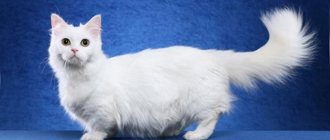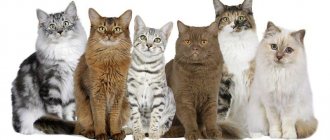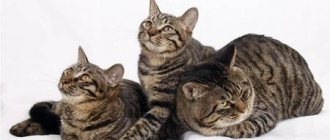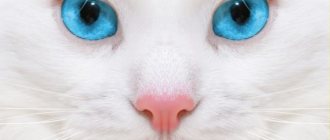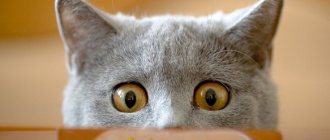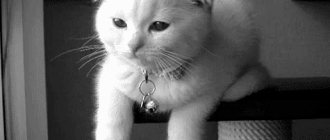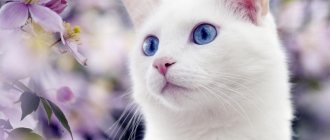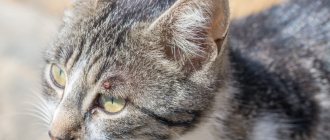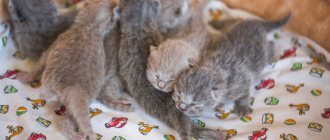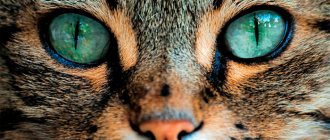Is a white cat with different colored eyes a special breed?
Not only purebred cats can be heterochromic; this phenomenon is also observed in outbred animals. Many people mistakenly think that a white cat or a white cat with different eyes are representatives of some special breed. Indeed, among representatives of some breeds, for example, Turkish Van, Turkish Angora or Kao Mani, heterochromic individuals are very common.
But the British, the Scots, the Persians, the Maine Coons, the Rexes, and the most ordinary yard cats can all have different eyes. For example, the world-famous snow-white beauties with different eyes, Iris and Abis from St. Petersburg, are mongrel.
The effect of heterochromia on vision
Most studies show that a cat's eye color does not affect vision. But in the case of heterochromia, you need to pay close attention to your pet. If cats have different eyes since childhood (which means the anomaly is hereditary), then the pet’s vision is fine.
If heterochromia is the result of an illness and treatment with medications, then consultation with a veterinarian is required. When the eyes change color not in a small kitten, but in an adult cat, pathology may develop. For example, glaucoma, for which eye drops are prescribed, impairs vision.
Top 4 breeds of white cats with different colored eyes
Turkish Angora
Kitten breeding experts claim that this species is the most common. This breed of cat first saw the light of day in Byzantium. Namely in the city of Angora, so part of the name comes from this. At the beginning of the 16th century, the Turkish Angora was brought to Europe.
The angora's coat is long, silky, but thin; its muzzle has a more elongated shape. Males are small in size. They have a very peaceful, kind, playful and affectionate character (see full description of the character of the Turkish Angora).
Scientists say that this breed often has blue eyes, but there are individuals with different colors. The immune system is very well developed, however, what confuses some owners is that they are partially deaf.
Turkish Van
This cat is not very famous, so it is not particularly popular. The name comes from a Turkish district called Van, hence the name of this white cat.
He also has different eye colors. Often one eye is blue and the other is yellow or orange. Such pets can rightfully be called fluffy, because their fur is soft, silky, although not long. Turkish cats are quite smart and can easily be taught some training techniques.
Van cats are very active and love to play pranks. In your house they will always find a high point where they will definitely need to jump. In nature, these are hunting cats, so they are not afraid of bodies of water. As a result, if the owners need to wash the cat at home, it will not be difficult.
The Turks themselves believe that this cat brings good luck and if you keep it in the house, it will help you achieve your goals in life. It is precisely because of such reasoning that a monument to this breed was erected in the city of Van.
Khao Mani
“Diamond eye” or “white pearl” is exactly how they speak about this type of kitten. And this is not surprising, since the appearance of such a cat resembles a queen. This conclusion cannot be easily made, because in Thailand, khao mani was bred specifically for royal families.
For these reasons, such a breed is not easy to acquire, since it knows its worth. Thais believe that having this animal brings them prosperity, good luck and peace.
Their fur is short and their body size is small. However, such a kitten does not like to be left alone, because it is very sociable and friendly. The cat is truly royally clean, so it is very easy to care for her.
Persian cat
Persians are considered the most common cats in the world. Since they come in different colors, the white ones with different colored eyes are a really great find. However, for such a find you need to pay twice as much.
Of course, it also happens that heterochromia occurs in other breeds, but this is more often explained by the fact that this has occurred to some extent as a gene mutation. Therefore, if you want to buy a white cat with different eyes, we advise you to choose one of the breeds listed in this article, or you can see what kind of white cat with blue eyes there is from several breeds.
Is this a disease?
Congenital heterochromacy is not a disease and does not affect a cat’s visual acuity in any way. But it can affect your hearing.
But if we are talking about purebred animals, then such an individual is removed from the breeding program in order to minimize the possibility of the birth of deaf kittens and stop the spread of the defect in this species.
Acquired difference of eyes occurs due to injury, disease, inflammation, tumor.
There are two types of acquired heterochromacy:
- Abnormal darkening of the iris. It is caused by iron deposition (siderosis) and can also be triggered by the use of certain eye drops by stimulating melanin growth. These are, for example, drugs to reduce intraocular pressure, which are used to combat glaucoma.
- Abnormal lightening occurs due to atrophy of the iris due to inflammation, due to neuroblastoma, melanoma, uevitis, leukemia and some other pathologies.
Beauty and deafness
Unusual beauty has a downside - many heterochromic animals have serious hearing problems.
Alas, cats with different eyes are often deaf - completely or partially. Moreover, in the latter case, the ear located on the side of the blue eye usually does not hear. The reason for this deafness is genetic, it is the result of the action of the white color gene W.
Its dominant allele blocks not only the production of color pigment, but also the development of hearing aid cells. Fortunately, breeders are resisting, and quite successfully, the spread of deafness of this kind in the population.
Reasons why cats have different eye colors
In some situations, various infectious and non-infectious eye diseases and eye injuries can provoke differences in the eyes. But in most cases, this is a congenital feature, which is caused by a lack or excess of the coloring pigment melanin, which is responsible for the color of the iris.
. It is noteworthy that the difference in the eyes of kittens cannot be seen immediately after birth, because for at least 4 weeks after birth, the eyes of all babies are cloudy blue, and they begin to change only then.
Save and increase
For a hundred years now, the Ankara Zoo has been running a program to breed white Angora cats with different or blue eyes.
At the beginning of the last century, unusual Angora cats found themselves in danger of extinction: the gene for long hair was actively used in the development of new breeds, and there were catastrophically few purebred Angoras left. In 1917, Turkey decided to preserve the breed as a national treasure, and for some time local animals were even prohibited from being exported abroad.
Now other white cats with different-colored eyes are bred in the world - and the British Shorthair breed is not lagging behind in this. For example, a nursery for odd-eyed Britons operates in Rotterdam.
How to embrace the immensity: the main varieties of cat colors
Diversity is diversity, but no one has canceled systematization. Therefore, all possible colors of cats were divided into several groups.
Table: main groups of cat colors
| Color group | General characteristics of the color group | Colors included in the group | Description of color |
| Solid colors | All hairs are well dyed to the roots, without patterns or any stains |
|
|
| Silver colors | A certain area of each hair is bleached white |
|
|
| Acromelanistic colors (colorpoint) | Body slightly colored, light (from white to cream); paws, tail, muzzle and ears are darker. |
|
|
Monument to Beauty
In Turkey, near the largest alpine lake, Van, there is a monument to white, odd-eyed cats of the Van breed. At the entrance to the city of Van, not far from the lake of the same name, there is a monument depicting a pair of white cats with different eyes.
This is very symbolic, and not only because the Turkish Van is a native breed of these places, but also because Van cats, unlike many of their counterparts, are calm about water and even swim beautifully and catch fish deftly. The Van breed has been declared a national treasure, and its image is embossed on a coin.
Diet selection
Angoras also do not need a special diet.
If you decide to feed your pet dry food, purchase premium or super premium food. You can buy food with additives specifically for long-haired breeds to remove hair from the stomach. Sometimes you can give wet food, but it must also be of good quality.
When eating natural foods, it is necessary to maintain the correct proportion of substances. More proteins. The diet should include fermented milk products (but milk should not be given), raw, heat-treated meat and fish, eggs, and vegetables.
For white Angoras, liver, heart, and seaweed should be excluded, as these products may cause the fur to turn yellow. This does not affect cats of other colors.
Kittens are fed 5 times a day, introducing fermented milk products for a sufficient amount of calcium. Adults are fed twice a day at set times. During shedding, supplement with fat-soluble vitamins to reduce hair loss.
Clean water should be available at all times, regardless of the type of food.
Turkish Angora Temperament
The spectacular Angora cat breed is distinguished by its sociability, high level of socialization and developed intelligence. In its new family, the pet will treat its owners tenderly and lovingly. These cats do not show aggression and behave with restraint, so they can be kept in families with small children.
The cat has a rather active temperament - it is playful, loves active physical activity and loves to be the center of attention. Your pet will appreciate all kinds of interactive toys, exercise equipment, scratching posts and other accessories that allow you to release the accumulated charge of physical activity. In addition, the Turkish breed of domestic cats has good learning abilities - the pet can master tricks and surprise the owner with its intelligence and intelligence.
Purchasing a kitten
A purebred Angora cat, the price of which depends on the class of the pet, is in consistently high demand. Therefore, for animal lovers the relevant question is: how much does a cat cost and where can it be purchased? It is worth noting that breeders from all over the world are engaged in breeding Angora beauties, so you can find an excellent nursery in each region. The cost of a pet can vary greatly. It depends on the appearance of the cat, its gender and the degree of compliance with breed standards.
For example, a “pet” class pet costs no more than $200, while a “breed” class show cat is available at a price starting from $400. The cost of pets of the highest “show” class can be 600-800 dollars or more.
The description of the Angora cat breed allows owners to conclude that the pet’s active and lively temperament will become a loving pet. These cats are affectionate and playful - they get along well with everyone around them and do not show signs of irritation or aggression. The cat completely devotes himself to his new family and throughout his life demonstrates devotion and affection for his owners.

